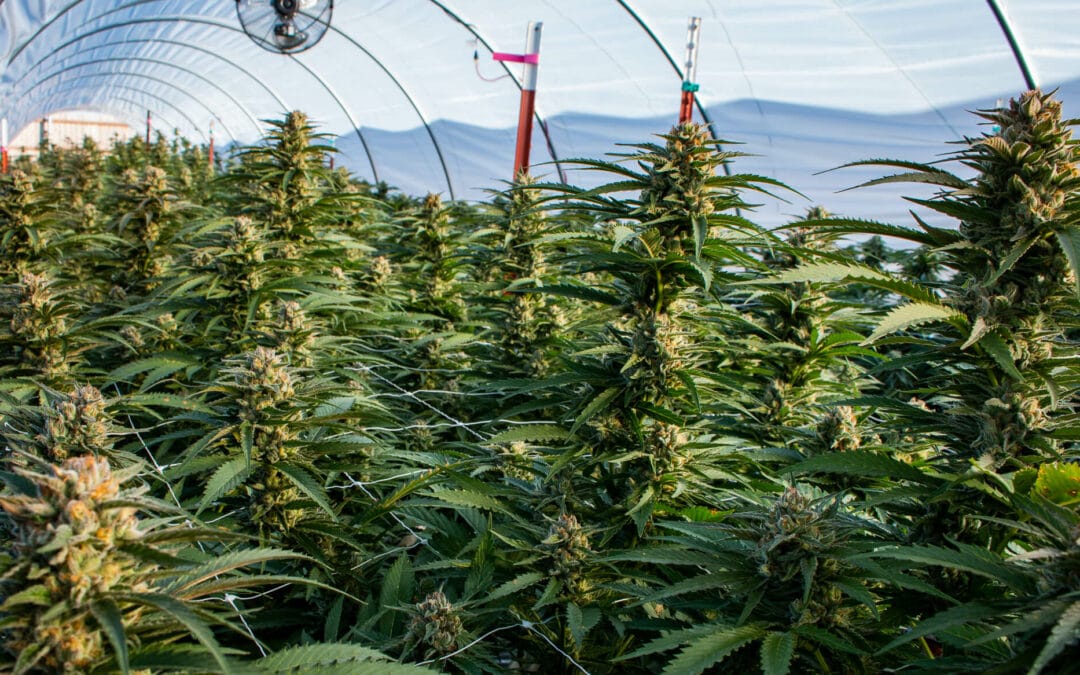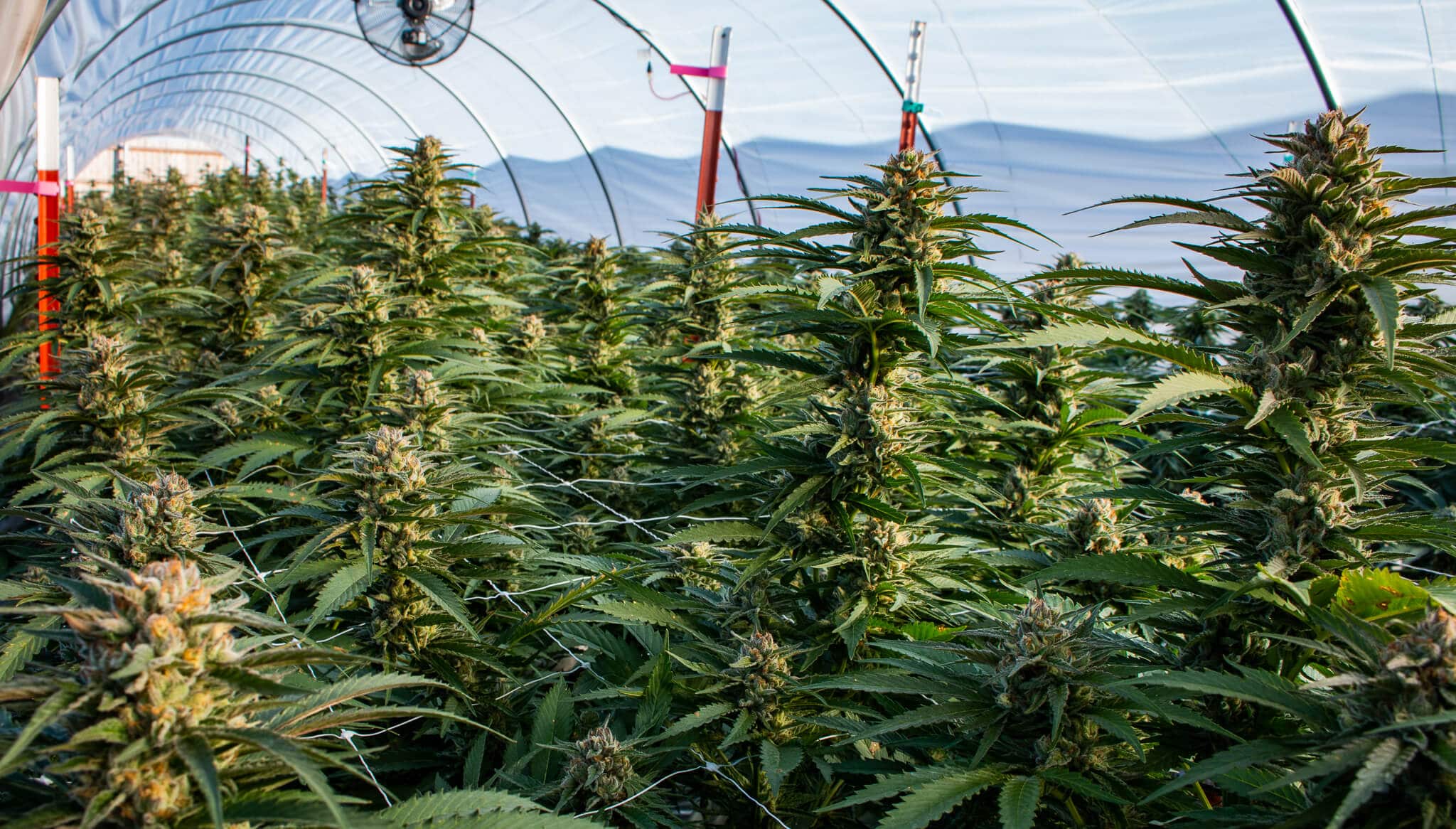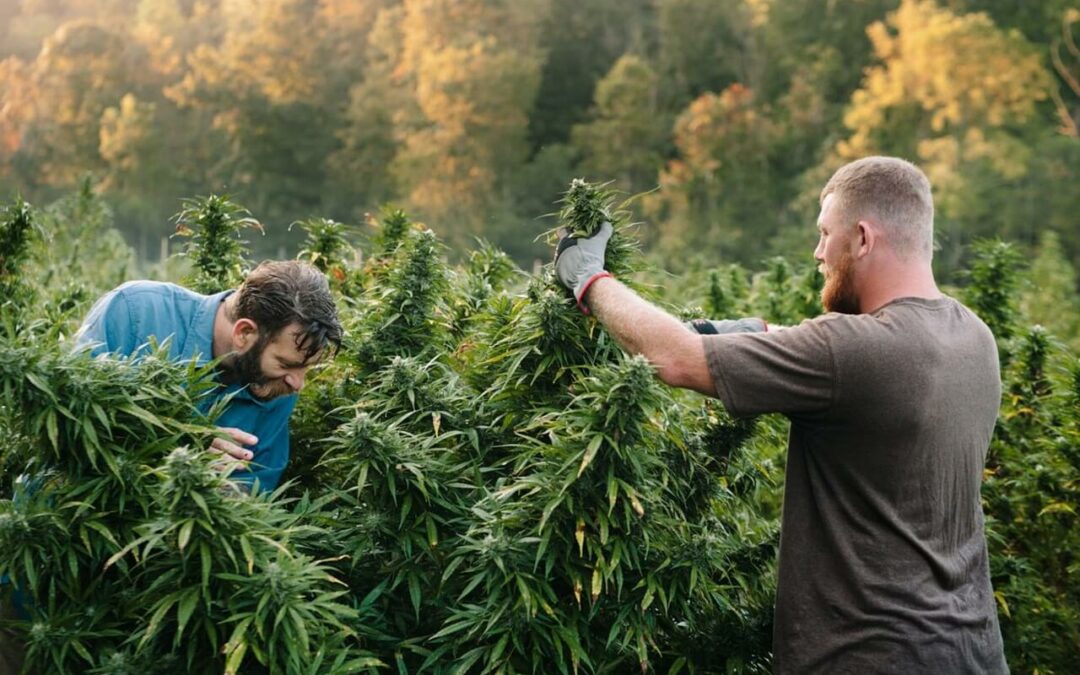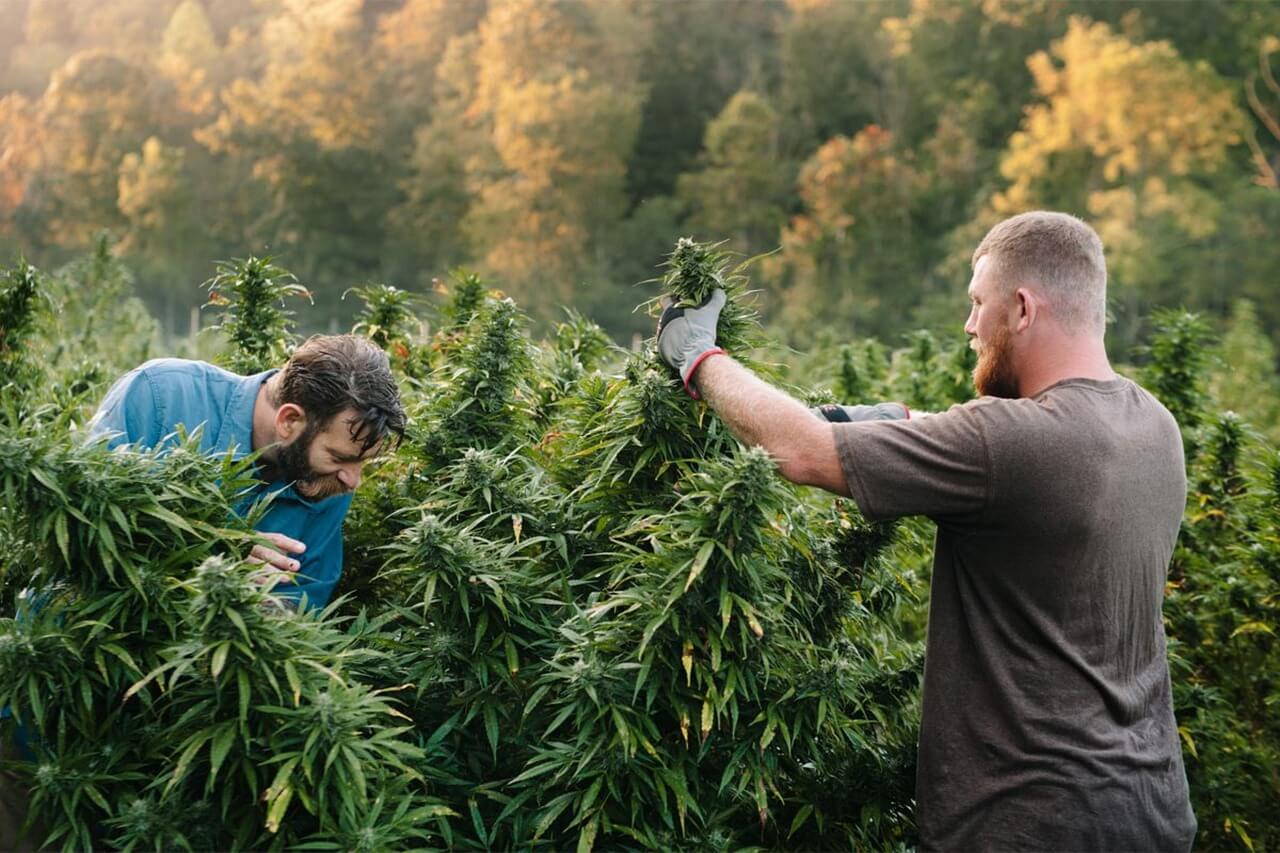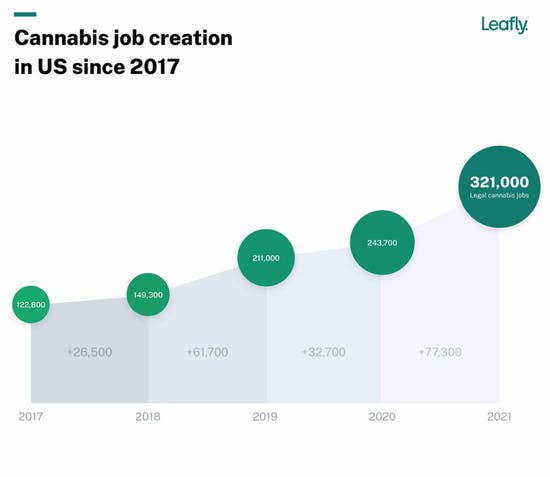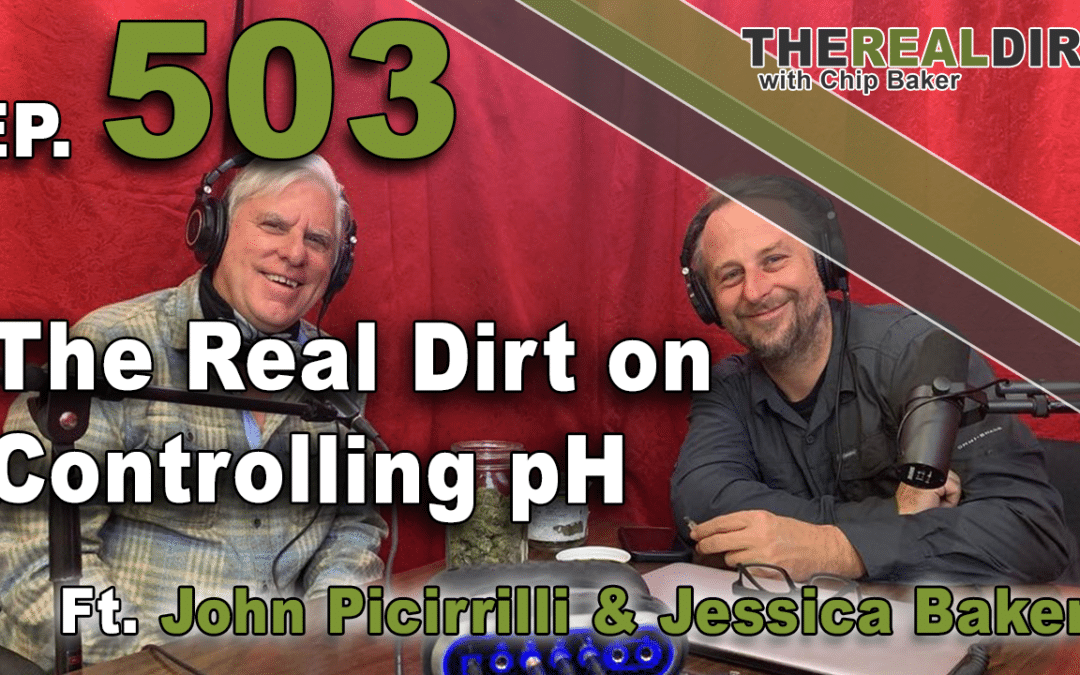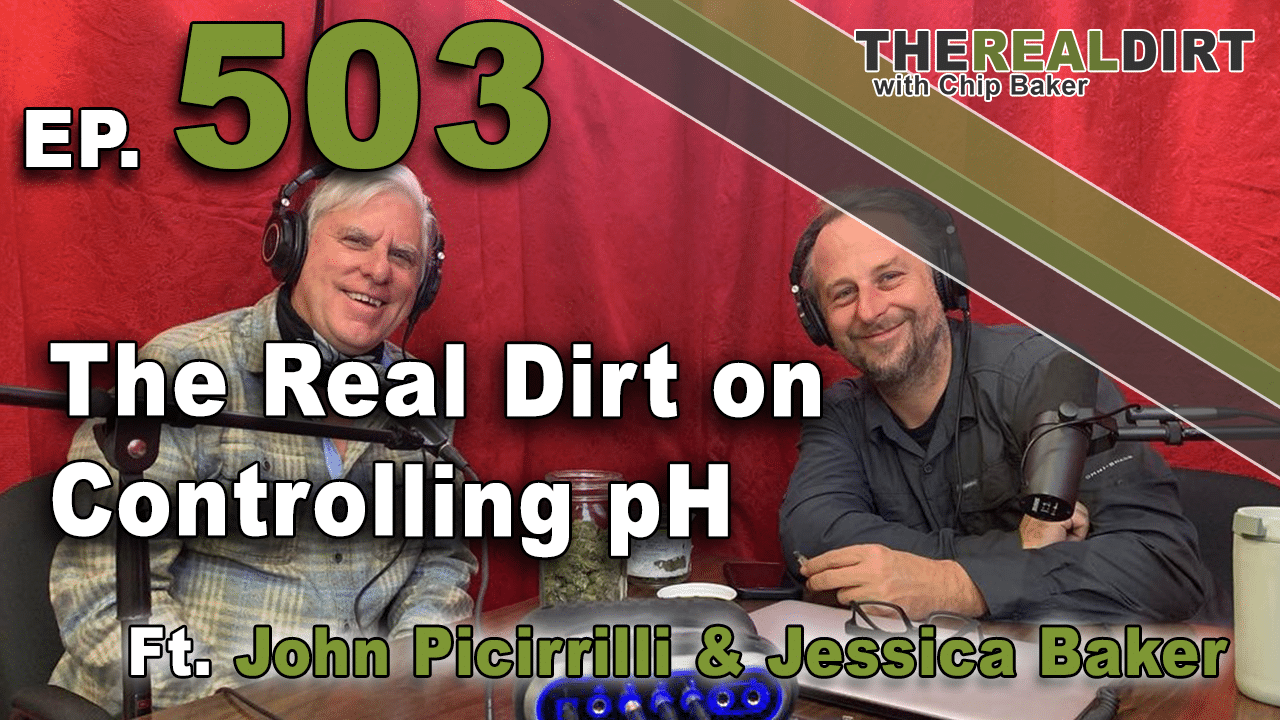In This Episode
If you haven’t already guessed, this episode is all about pH! From what it is and how to monitor it, to the most common pH problems and the most complex, and how to solve them. Get the real dirt on pH and why it’s important in another awesome, educational episode of The Real Dirt with Chip Baker!
Transcript
Chip: Alright, look at who joined us, man.I tell you, I got two of my favorite people in here. I’ve got the famous Jessica Baker of Baker’s Genetics, Baker’s extract. How are you doing, Jessica?
Jessica: I’m doing well. How about you?
Chip: Oh, I’m doing excellent. I’ve also got a John Piccirilli here of Cutting Edge Nutrients. How are you doing, John?
John: I’m doing very well.
Chip: Well, I’ve gathered both you guys here today, because I want to show you something.
Jessica: Okay.
Chip: Yeah, I’ve got some weed over here.
Jessica: I see the weed.
Chip: Yeah, I’ve got some weed over here. This is all grown with Cutting Edge nutrients. These are Baker’s Genetics. What does that mean, Baker’s Genetics?
Jessica: I guess it means a lot of different things. For this purpose, this just means that you know, the cannabis that we have grown and are here, we’ve chosen the phenotypes from these seeds and decided which ones we want to keep.
Chip: So Jessica runs a clone nursery, and a dispensary, and extraction facility in Oklahoma City. Why don’t you pick out some weed and tell us about it over there, Jess?
Jessica: Okay, so this big jar is Lemon G 13 crossed with Do-Si-Doe. This is an archive seed that we have planted out and kind of chosen the ones that we liked the best.
Chip: Hey Pat, why don’t you pass the smaller jar over here? Here’s some Oklahoma greenhouse, John. What do you think? ‘Cause you’ve been all over the world, seen some of the finest weed in the world.
John: Whoa. I just, I picked out what I thought was gonna be a decent size, but it’s gigantic.
Chip: [inaudible 1:41].
John: Terpenes.
Chip: Terpene.
John: Love this stuff.
Chip: I mean, G13 Do-Si-Dos from archive seeds, as part of this moonboat collection, I believe.
John: Definitely has a lemon and crystal.
Chip: Yeah. Yeah.
John: So what, is this being passed off as indoor? Don’t say that on the radio.
Chip: Just don’t say that on the radio.
Jessica: We have some indoor late G13 and some greenhouse.
Chip: You know, you know, we get to do it all. Indoor, outdoor, light dep, greenhouse, right? But you can tell, you can tell. You can tell the difference. You know, and you know how you tell, is the greenhouse nuggets are huge.
John: Indeed.
Jessica: That’s mold resistant. The G13 was really mold resistant.
Chip: This was a really good strain for us here. Hit really well. Hey, could you pass over the –
Jessica: I’m rolling this one up as we pass.
Chip: Cookies and Cream? That’s the ball jar.
Jessica: Oh yeah, that’s right. This is the ball jar. This is a really good one, too. So this was Cookies and Cream, exotic genetic seeds. We planted a bunch of seeds. And then, we chose a couple phenotypes. Right now, there is, we’re in debate on which of the two top phenos we actually like the most. So to be determined on that one.
John: Has Ice Cream to it.
Chip: Yeah, yeah, absolutely.
John: I like that.
Chip: It’s very vanilla-like, almost.
John: Mhmm.
Chip: Right?
John: Smooth.
Chip: Mhmm.
John: And when you crush it, it’s got more of the Cookies.
Chip: More, yeah. More of the Cookies. These are a great, great, great strain. Yeah, these were all Cutting Edge Nutrients –
Jessica: Growers soil.
Chip: Growers soil. Hey dude, do we have any of our, the previous light dep crop, Jessica? The outdoor crop over there?
Jessica: I don’t think so.
Chip: I don’t think so either.
Jessica: Does not appear to be, we do at the dispensary, but –
Chip: Okay, too bad. Well, because of you know, one of the things we noticed, John is, we kind of got a large, fairly large operation. 30,000 square feet, you know, auto flower, 60,000 square feet of outdoor, then you know, another 8,000 square feet of this greenhouse, and 8,000 square feet of that greenhouse. And man, it’s a little overwhelming.
John: A lot of work.
Chip: It’s a lot of work, you know, we don’t have that many people that work out on the farm. And it’s also just, you know, we were talking about scale on one of the last episodes, it was hard to set the pH, right? And we worked on pH within the soil, and we tried to just balance it that way, and I think we did a pretty good job. Because our source water coming out of the well is 7.8 and that’s just straight well water here. And we’ve got a really kind of high parts per million. But, we were just adjusting the soil with enough acidity, where the pH would be balanced. And I feel like we did a pretty good job that way. And we did it in both like, the ground and in pots. But these crops right here, containers and we control the pH perfectly. The mold, the color, like, all of it improved, you know? It was dramatic. And you know, I’ve always seen what pH can do, but I’d like to talk to you about like, the importance of pH, and why we should think about it in our gardens, and how we should we should deal with it.
John: So, you took the pH of the water, but did you do a soil test to take the pH of the soil?
Chip: Sure, sure.
John: What was that?
Chip: Sure. We did it right. We sent it off to a lab, the water and the soil. And then the lab gave us a formula to adjust it down, right? The original pH of the soil was like, the 7.2, or something like that.
John: So you adjusted it down.
Chip: Down, yeah, yes.
John: With sulfur?
Chip: You know, we used, Jessica, do you remember what we used?
Jessica: You guys are being all serious over here. I’m like, coughing as I smoke this.
Chip: I think we used two things. Sulfur and acidic fertilizer, chicken shit, bat guano, and fish emulsion.
John: Did you use Plant Amp?
Chip: Well I mean, you’re just talking of a few acres of stuff here.
John: Right, right.
Chip: Right. Well, that’s why it was so hard like I’m saying. And that’s why we could only control specifically the pH on this one 8,000 square foot greenhouse. We could control it every single watering and how much better it did.
John: Right. And that wasn’t in soil that was in your soil?
Chip: Correct.
John: Right.
Jessica: The plant bags.
Chip: And to tell you it was even, I mean, the pH issues were in the potted plants that we were feeding on pH water. It was significant. The stuff in the ground, you could hardly solve the problem, right? I mean, it came out in the mold and the health of the plant, I think in the long run, right? As we get like, next to no mold, no bug problems in our perfectly pH-ed gardens.
John: And you really saw a difference between that and the soil that wasn’t pH-ed? Yeah.
Chip: Oh, yeah. Oh, yeah, big time. The stuff in the container’s not pH-ed. It’s kind of just crap, honestly. Like we ended up extracting it. You know, I’ve got a bad opinion. If it’s not great, great, great, great weed, I don’t even want it. It’s awful. Throw it away, you know?
John: Yeah, I can see that.
Chip: But you know, it’s a controversy to check your pH or not. Oh, you don’t have to check your pH. I never do anything for it. But you got to do something, right?
John: Well, you know, it depends whether you’re feeding the plant, or whether you’re just, you’re adding amendments in the soil. And growing in the soil, in the ground, or whether you’re growing and saving your soil mix, and you’re adding amendments to that, and you’re just watering. Because if you’re using liquid fertilizers, it’s naturally going to go be pulled down temporarily. The plant itself adjusts pH, you know? pH means potential hydrogen. So plants will pull up water, they’re pretty amazing. They make their own sugar, you know, and are able to have enough energy to split water. So they split water off from hydrogen and oxygen. With that situation, you get extra oxygen. And that’s why plants emit oxygen, we can breathe. But the hydrogen and some of the oxygen, oxygen are used with carbon in order to make the plant’s body. But there’s additional hydrogen that are hydrogen ions that are emitted out the roots of the plant. And the plant does that to break down minerals in order to suck the nutrients or minerals back up. So when you’re measuring pH, pH means potential hydrogen ions. So there’s already hydrogen ions in the soil. And that reading that you get where seven is absolutely neutral means that that’s the difference between hydroxyl ions, which would be a buffer and give you high pH, and hydrogen ions, which would give you low pH. So really, what you’re looking at when you look at pH, you’re looking at what the plant can feed itself right away. And if it’s too high, you know, it’s not going to get certain minerals. And if it’s too low, then only, then it’s not going to get other minerals. When it’s lower, it’s going to get calcium, iron and manganese, which is key for cannabis. So pH is important. But really being able to feed, like when you’re adjusting the water, the pH of the water and you’re adjusting it down, you’re giving the plant a chance to pull up some nutrition really quick. So it’s good to adjust the pH of the water when – adjusting the pH of the soil, that’s a long term process. That’s why I always used your soil.
Chip: Right. Well you know, and we do that too. I mean, I make potting soi. So of course, I love the potting soil. But like, we use all the technologies. I’d love to grow in the ground. It’s a little difficult to, you know, make containers for the thousands of plants we’re growing. We got a small operation. I like growing in the ground.
Jessica: I like growing in the ground too.
Chip: So what does this mean? You look like you came in here, Jessica, you fired up a joint, now you’re leaving?
Jessica: I basically have an appointment I have to go to. You know, I basically just came in here to make an appearance, to smoke you guys out, to make both of you look good today. Sorry about that.
Chip: I wanted – oh, okay. Well, maybe next time you’ll come out and we’ll have more of an in- depth conversation about pH.
Jessica: More profound conversation?
John: And she takes excellent photos, look at that.
Chip: I’ve been training. We’ve been training.
Jessica: I’ve been training. Chip’s been training me on photographs since the 90’s, back before digital photography.
Chip: She’s an excellent photographer now.
Jessica: And you know, I can, I’m okay. Sometimes I’m okay. Quite.
John: Oh, that was great. I mean that’s great on the IG.
Chip: Yeah, yeah, totally.
Jessica: Straight to IG, yo.
Chip: I mean, just a little bit of cropping, maybe a little color and trust me, you’ll be fine.
Jessica: Totally. Well, it was good seeing everybody. I’m good on that joint. I’ll leave that with you.
Chip: Okay. Hey Jessica, and if anybody’s interested in getting in contact to find out more about your live resins, batters, butters, sauces, diamonds and pearls, how do they get in touch with you?
Jessica: No pearls, but they can get in touch with me at jessica@bakersbrands.com. Or if you are interested in clones, clones@bakersbrands.com.
Chip: You’re on Instagram, Facebook?
Jessica: Instagram, @cannabis – no, hold on. Instagram is bakerscannabisoklahoma. Facebook, I believe is just @bakerscannabis. And, you know, I’m an acupuncturist and herbalist. So if you care about other plants @baker_botanica on Instagram.
Chip: Alright, excellent. I’m glad we had that. That excellent visit with Jessica. She’s always so busy with stuff she’s doing.
Jessica: I’m always so busy. I’ve got important things to do.
Chip: Okay.
Jessica: Bye.
Chip: Bye.
John: Bye.
Chip: Oh wow, she’s great. She always comes in in a tornado. She like, throws weed everywhere. She smokes the place out, and then she leaves. It’s like, the Lone Ranger or something. The Stoned Ranger.
John: Absolutely.
Chip: Who was that masked woman?
John: And to you there in audience land, she was wearing a mask.
Chip: She was wearing a mask with that shirt. This crop here, you know, I really wanted to make it great. And so you know, we spared no expense. We used you know, your full directions of Cutting Edge fertilizer, your supplements, even your, some of your organic stuff. We pH-ed every single, you know, gallon of water that went into the plants. And I mean, it is incredible at how vigorous like when you, when the whole combination comes together. Right? It is just incredible how vigorous the plants grow, how much better they are. Man, you have to sacrifice like either the nutrition, or the pH, or the potting soil, because of the volume or the scale of it.
John: Yeah, I mean, pHing water is pretty important. A lot of people get this side benefit. So you know, in the western United States, you have a lot of calcium bicarbonate that comes up in the water. And by using phosphoric acid, it binds with the calcium causes to fall out, and then the bicarbonate gases off as CO2. You can do that. It’s good to also aerate. Even if you have a 5,000 gallon water tank, if you get a massive 5 horsepower air pump or something, and blow air into there, just big old bubbles, it’s going to cause the, if you pH down to 6, it’s going to cause all the calcium bicarbonate to fall out. And you have to have a Y at the bottom of your tank with two valves. One goes to your field, the other you know, runs off to somewhere where you’re going to create a lot of clay slop, because it’s going to take out the, the iron is going to take out the calcium. And, those two things in the forms they are in will tie up the fertilizers.
Chip: So wait a second, you’re suggesting that, because I think I can use this on our farm.
John: Yeah.
Chip: Yes, because we have five capacity on tanks. And that’s probably why you said that to me. So subliminal there.
John: A lot of people have copied you and they have 5,000 tanks too.
Chip: So I should drop my pH to 6, and then bubble the water vigorously. And then do you –
John: In 24 hours.
Chip: 24 hours either you turn the bubbler off, let it sit and then you drain out the sediment?
John: It’s already had a chemical reaction.
Chip: So it’s already settled.
John: Right. So by turning it off in an hour, the rest of it that’s maybe coming up from the bottom will all settle out. And you’d be surprised, you know. When your water is 7.2, when your water is 7.6, there’s so much more of that calcium. You turn on that waste valves –
Chip: It’s unusable to the plant.
John: Right.
Chip: Right.
John: It’s unusable to the plant. It’s just, it helps buffer the soil. It’s one of the reasons why you have higher pH soil. I mean, you see that a lot of red clays. And, you buffer it more. It’s not necessarily good for the plant, for the type of plants we’re growing. And when you turn on that waste line that comes from the tank, maybe nothing will come out. You’ll have to kick that line. And then slowly, you’ll see like, this extruded clay coming out. That’s all junk that’s tying up your nutrients. And you can add more nutrients and overcome this, but I’m not trying to get rich on this radio show. I’m trying to tell you how to save money.
Chip: No, you know, and that’s where we’ve always really aligned, John is like, we just want to help people grow. And you know, people will come in, and I’ll give them the easiest way to solve their problems. But they want to spend some money. And so they like, buy a problem solver, right? But I always offer the mechanical solution to people first, if there’s one. Something they can easily do by hand or, this is great. ‘Cause we’ve kind of talked about this before, I’ve had bad water in the past for sure. And not that our water is just awful, but it does come out of the well at 400 parts per million?
John: Yeah, you’re right there with calcium bicarbonate.
Chip: Yeah, that’s calcium carbonate, for sure. For sure. So alright, well, I’m gonna try this man. And now will this change the pH, will this change the EC or the ppm of the water?
John: Yeah, it’ll definitely change the ppm of the water coming out. And you’ll see that you’re going to use less fertilizer to be able to get to the same point. And then if you use compost tea, you’re going to use less fertilizer. I have customers that I’ve told this to, when they followed that through, they came back and I said, “I pretty much can guarantee you’re gonna be able to cut your fertilizer bill by 30%.” But they used tom tea enough and they cut it by 50%. And I was like, that’s great. And he looked at me like I was crazy. But you know, it’s not about –
Chip: Oh yeah, yeah. No actually, I want people to be more effective with the fertilizers and the products we sell. And they’ll be better businesspeople, they’ll make more money, they’ll be better growers. And, you know, they’ll remember that. They’ll come back and do more business with us.
John: Right, and what one of the groups of people that we’re always focusing on is phenotype hunters. You really need to have your program dialed in to see what the genetic potential is of what you’re working with. And there’s quite a few people out here in Oklahoma doing that now. It’s pretty exciting.
Chip: Oh, Oklahoma is the pheno hunting capital of the world right now, I think. With what’s happened with the cannabis seed industry, right, at the same time, and the light regulations in Oklahoma allowing for no square footage issues, no plant issues, you plant as many seeds as you want. Right? We just got off a 4, 500 – it seems like we plant about 4,500 seeds for 10,000 square feet. So it’s been working for us. And we just have been doing it over and over again. Auto flowers, traditional male, female plants, feminized, photo sensitive plants, it’s been great, man. It’s just really, really been incredible to see all the different genetics, all the different phenotypes, to see the breeders that are for real.
John: Right, yes.
Chip: Right? And the ones that aren’t, because they’re out there, man. They’re out there. Hey then, I’ll tell you this. CSI and Archive, I know you guys have heard me talk about, I know you guys know these guys are my friends. But man, they got the best shit. Like, we planted 20,000 seeds out probably this year, and theirs were the best. Absolutely. The strongest, the most vigorous, the most what they said they were gonna be. Just the quality of the flower like, it was just incredible. So CSI, Humboldt, Archive Seeds.
John: Yeah, and Finest is right there too.
Chip: Oh, man, we’ve planted a bunch of Finest. I mean, there’s a lot of great, great breeders out there, don’t get me wrong. But I mean, we planted out Brothers Grimm Seeds this year. We planted out Exotic Seeds. We planted all the bests, but of everybody’s, dude. CSI and Archive’s. They were the best.
John: Yeah, and there’s breeders that came from California here like Brandon Rust, who won third place in the Cowboy Cup with Death Breath. It’s an amazing flower. I’m sure now it’s probably unobtainium because it really is that good?
Chip: Unobtainium. I’m gonna write that one down. Unobtainium.
John: You cannot find it probably.
Chip: Unobtainium. Yes, scale is going to be one of Oklahoma’s biggest problems, right? And this water quality, this pH issue has absolutely been one of my biggest problems. But there’s this bro science with the, you know, with limited success comes this like, enforcement on something that’s actually didn’t, was a negative but since, you know, it worked out for you, you thought it was a positive. Right? And I literally just this past week got in just two different like, conversations with people on pHing their containers, right? They’re growing inside, they’re small growers, they’re not even at scale. And, their argument is, “I’ve never pH-ed my plants, and my plants are fine.” And they’ve just never had a pH problem. And it’s easy not to have a pH problem when it’s small like that, but when it scales, that’s really, really when you, really when you see it. I know you’ve seen some big farms here and in California. Like, you know, what are some of the ways that people deal with fertilizer injection and pH control?
John: Well, there’s a whole range of ways to deal with pH and injectors. And it seems like –
Chip: Let’s keep it with container-grown.
John: Okay. Yeah. Yeah, okay.
Chip: Okay. Since I’m make potting soil and all.
John: Dosatrons. Dosatrons are really popular. You know, they’re powered by water. You put a clipboard up and just clean it no matter what, every month. And they’re easy to take apart, easy to clean, no reason not to use them. You know, all our fertilizers go through those.
Chip: You know, I see Dosatrons being used two different ways. We’ll get to the nutrient first, and then we’ll go to the pH, because this is the pH show. I see way number one is where you have five different components. And so, you have five different Dosatrons. The best way to do this is to dilute all of your nutrients with distilled water, at least by half, and then you can use a large volume to come through the Dosatron. Right? And in my opinion, the most success I see people doing really well, this well. And you know, it’s a siphoning unit. So, it just works better if more volume goes through the unit. And when you’re talking about a mL of a nutrient, like, it really is better to have two mL go through the Dosatron than one or even five, honestly. And then the same thing with the, any of the NPK. But the other way, is people take one large stock tank, they mix like 55 gallons, right? And they fill it halfway full of water, and then they put all the stock nutrients in the tank, all their 5 or 10 different components. And then they have one Dosatron. Is there any preferred method or any reason to use one over the other?
John: Well, the cost. You know, Dosatrons aren’t really that expensive, but some people want to use one doser. And I had a customer in an heirloom tomato greenhouse in the central coast in California, and they wanted to be able to use one doser, that was it. And so you can mix our fertilizer line times 13 in that heavy concentration. And it will all go through, and you could set one D40 Dosatron to that. They make a D3000 now, and that can take one ml per gallon. So you can dial it in, say for 10 mLs per gallon really accurately. So you get one of those, and you get a maybe a D15 or a D40. And then you can put the others stock nutrient in through that. Because you don’t want to mix calcium with everything else. Otherwise you get locked out, right? So –
Chip: Even if you dilute it halfway with water?
John: Yeah. You can’t take that chance because then, somebody does that inside, and then they do it in their greenhouse and they want to do it in the field, and they get evaporation in the field. And then you get that problem again. And they, you know, by the time they’re out in the field, they’re hiring so many people and they have other operations going, they’re not watching things closely.
Chip: So I mean, what you’re saying is you really suggest at least two Dosatrons.
John: Yes. Two.
Chip: Two Dosatrons. One for your major calcium component, and then the rest could go all mixed together. Now if I’m using your three part, how would I, put the micro under one dose, and then mix the grow and the bloom in a stock solution with 50% water?
John: Yeah, you don’t even need 50% water.
Chip: Oh, you could just mix it straight.
John: Mix it straight. Yeah, I made it that way for that reason, because I using dosers.
Chip: I didn’t realize I could I mix it straight. I’ve diluting it for years.
John: Oh really? I just did all this for myself.
Chip: Yeah. That’s why I developed all this stuff, dude.
John: That’s why you develop your soil right?
Chip: Oh yeah, hey man, this new plant in bags I have, the five gallon plant in bags. I mean, they made it to where I’ve just got three people that work with us. And we just ran 8,000, 10,000 square feet greenhouses, like over and over and over and over again, all summer long, I did it with three people, right? Three different sets of 8,000 square foot greenhouses pull, you know, multiple times over the course of the summer. The only way we could do it is with those plant in bags, the absolute only way to be able, to like, finish the crop. Take the old potting soil old bag out, and replace it immediately with a fresh bag plant in bag like, the labor savings was incredible. Incredible. And yeah, I knew that. And so that’s [inaudible 26:21] myself.
John: You know, we make our own mistakes on our own, on our own money, right? And then we try to come up with a solution, and then it becomes the product for your friends. And then it goes. Now, probably people listening are friends of our friends of our friends of our friends. It’s really gone out there now, but a lot of people doing it.
Chip: Oh, man. Everybody that comes in my shop’s so friendly. Rarely do I have someone who’s uncool.
John: Yeah, yeah. I mean, they go somewhere else for a reason.
Chip: So how do we deal with the pH with the dosers? How do you see people dealing with the pH?
John: So you don’t have to worry about the pH using our fertilizers, but there are other fertilizers that you want to adjust the pH. The actual, organic –
Chip: Because when you use your, just your three part, it adjusts appropriately?
John: Yes. You don’t have to adjust. It’s available from a pH of 3.5 to 9.
Chip: So it’s not that it adjusts the pH in the water, even though it will change the pH, it’s just available at the large ranges.
John: Right, right. They’re food grade components that are meant to use, you know, mountain spring water, Fresno ditch water or, you know, water sources from anywhere in Oklahoma.
Chip: Sure, no, I set mine just to let you know, I set mine religiously at 5.8 if I can with your nutrient. And I suggest everyone do that too. You know, I hear people do it all kinds of ways.
John: Yeah. Well, so many people, you have to plan for people who don’t do anything at all.
Chip: Yeah. And so that’s how you did it.
John: Right. And then so –
Chip: And hey, that’s how all of our other crops like I was saying earlier in the conversation is, you know, we weren’t able to pH it. We just put the nutrient in the tank, put it in the Dosatron and didn’t pH the water at all. You know, and it went out there. And we grew a lot of great, great, great weed. I should say good weed that way. But like, wow, man, it just got great as soon as I controlled all the nutrition, all the pH,.
John: Right. Well, in that case, you’re cutting out the calcium bicarbonate right? So you are gonna get a benefit all those fertilizers are available. And you know, that’s a side benefit of adjusting the pH and then aerating it even further does that. And that’s why people used to aerate their reservoirs.
Chip: Sure. I’ll be missing that. Yeah. Well, you know, we did use some. I have seen some really bad water here and the interaction with cheap fertilizer, right? I have seen it fall out. I’ve seen it clog. Like, we’ve had so many calls from customers who was like, “Oh, that drip irrigation, the filter’s not working,” right?
John: Or it’s working too well.
Chip: And that’s what it is. It’s actually like, it’s clogging all the time. And you talk to people and it’s like, oh, man, they’ve got really bad water. And they’re putting all this cheaper, you said it earlier, salt fertilizer in it. And it’s just creating this sludge at the bottom of the tank. Sludge, like in their lines, a paste or a clay, you said it.
John: Yeah, the calcium.
Chip: Yeah, on the inside of the filters. And we of course suggest everybody use the oversized Netta thin filters and promote the bigger ones, right? But yeah. Here, it’s a problem. We’ve seen it.
John: Yeah. I mean, a lot of people out here are pumping out of ponds, and they really need to use a sand filter. But you asked me about it, adjusting the pH on these other doser systems like, like doser system like Agritech from, that Mike has over in Colorado. Great doser system, uses peristaltic pumps. So it turns in, it turns out exact amounts. So you could do it when you’re –
Chip: Set up a siphoning unit, it has the paralytic pumps that proportionally pull it out, and then add it.
John: And then add it. And you can add as many of those pumps as you want. So you could have 12 different inputs, if you would like.
Chip: And that’s the best way to deal with the pH is with a paralytic pump, right? Instead of –
John: Well, they still have pH dosers. I mean, pretty much even Dosatron has pH dosers. I go to a lot of places and I see super high tech doser systems that either inject with air, actually use 100 psi air to inject the fertilizer into the line as it passes by. And I feel like that mix is best. Here in Oklahoma, there’s Andersen injector systems.
Chip: Oh, yeah, yeah. We’re a dealer for Andersen.
John: Oh, really?
Chip: Yeah.
John: Interesting. Do you have one in your store right now?
Chip: No, we don’t. But I’m going to put one in my greenhouse this next year.
John: Yeah. Those are –
Chip: I think Chris has got one in his greenhouse.
John: Oh, really?
Chip: Yeah.
John: Oh, cool.
Chip: Yeah.
John: Yeah.
Chip: He brought them in. They met together somehow. But yeah, really great systems. Nice people. Good, good customer service.
John: Oh yeah, great customer service. They’re right here in Oklahoma. And they, it’s all metal, right? So it’s really, it’s stainless. At least the ones I’ve seen at trade shows. I actually haven’t been to a facility that uses that. Other people have gotten so far in a different direction, where their doser systems are $120,000. And they’ve got a touchscreen interface and a number of different things. And it seems like people touch them wrong, and they don’t, and they’re so sensitive, they don’t like to be touched. Because they, in an A and B tank situation that was both supposed to go at the same time, it might forget, it might now have been taken offline for the B tank. And now your whole fertilizer program is out of whack. So I mean, surely there’s safeguards for all these things. But sometimes in doser systems, I like to see people just keep it simple. And I think Anderson, although it looks sophisticated, you know, it looks complex, I think it’s simple. And Agritech is still simple, and Dosatron is still simple. Other injector systems, you know, run off the entire, the environmental controller. and that’s interesting. But that’s more complex, and that would take another, a complete show to describe. But just sticking to the simple stuff of, should you be using pH up and down, I never recommend, okay, using pH down, as instead of using pH up. Always just use, bring the pH down, never try to bring the pH up. That –
Chip: Leave it where it is.
John: Leave it where it is, because that locks things out.
Chip: Even if it’s like really low? Or, you know.
John: I mean, what’s really low? Some people run our Plant Amp really low and then our pH will be going into the plant will be 4, and will panic. We get these calls all the time. And we go, “Look. It says do not adjust the pH.” Read it on our –
Chip: Oh, we’ve had the calls to the shop too.
John: Yeah, right. And I just say, “Well, look, why don’t you measure the pH of the water coming out the bottom or the fertilizer?” And they’re like, “Well, it’s 6.2 or 6.4.” I’m like, “Isn’t that perfect coming out of the bottom?” It’s like the plant is pulling out organic acids and converting and taking up the calcium.
Chip: So don’t adjust up, just adjust down. I preferred this for years anyway. I mean, there’s more than one type of pH down too, right? We’ve got you know, nitric acid, phosphoric acid, sulfuric acid, citric acid, which is their preferred product –
John: On Plant Amp, we have some other complex acids from the biochelation process but you know, just sticking to the ones you mentioned, you know, nitric acid, well you got nitrogen. Sulfuric acid, you know, sulfur get locks up with calcium, and you get calcium sulfate, which is gypsum wallboard, right? And you really don’t want that. And citric acid, you know, it’s a partial key later, but you can only use so much of that. Phosphoric acid, it’s kind of the choice of the industry.
Chip: Sure. I’ll have to say I use nitric. Because it’s so much more effective.
John: It is.
Chip: I used it when I can get it. Actually, this year, we just had to use the, for half the year we used phosphoric acid, right? Because we couldn’t really get the nitric.
John: Really, I wonder why.
Chip: I mean, it’s just a rough year on supply this year.
John: Oh, yeah, that too.
Chip: Right? I mean, you know it. I mean, we had so many, you know, issues, just shipping stuff around, or like, you know, warehousing issues, or people manufacturing issues, and then demand issues, everybody wants the product.
John: Well, they want it more and your customers that buy a normal clip, all of a sudden, they doubled that. Because they’re like, what if we can’t get it? I mean, that’s why I got another warehouse and filled it full of product. And got another warehouse and filled it full of inputs, because in the beginning, I saw it coming down.
Chip: You’re kinda in Oklahoma a lot these days. I mean, I’ve seen you a bunch lately. What’s going on with you here?
John: I’m just following the herd, like the bison.
Chip: Follow the wind, man.
John: You know, you’ve got a lot of, a lot of my customers from Michigan, Washington, Oregon, California, other states, but those four primarily, who our legal operators have moved to Oklahoma, to open up. And, you know, there’s a number of reasons for that. I mean, look at the transportation. I’m in Tulsa right now. Well actually I’m here in OKC talking to you, but you know, even here, you just look at the map, and you’re like, “Well, I’m two hours from 40.” And that’s where all the rail lines run, you know? You’re really close to Norm and where it’s like the highest rail traffic in the country, you know? You go two hours from here, and you’re at 70. Two hours further, and you’re at 80, you know? Going back down south again, you know, there’s the railhead in Norman, you could send things down to the Gulf. Now you’re shipping them all over the world. So, you know, what is someone going to do? Well, it would be a good idea to have a growing facility here in Oklahoma.
Chip: R&D.
John: Right. You can do a big pheno hunt, for one. It seems like the state is just encouraging that.
Chip: Oh, yeah, it’s great man. Like, Oklahoma is right off the center of the country, we really are here. It’s a great place to measure what the rest of the country is. I know there’s lots of stereotypes about it here. But, you know, this is like average America, really. Right? This is, it’s average, it’s new to the cannabis industry, and they’re really embracing it great. It’s incredible, right? As opposed to like, the other markets we’ve been involved in, you know, it’s this whole exclusive market scenario. And man, I just like that weed’s for all, and it should not be exclusive. Anybody should be able to get involved with it, in my opinion.
John: Yeah. Well, you know, I’d like to say people are friendly and accepting. But I think we’re going too far in boosting Oklahoma. Being a Californian, people would say, Northern California, I don’t want to go there. There’s gardens everywhere, there’s farms, there’s violent people. And then when they get there, they find people friendly and accepting and open and a big community.
Chip: It can be.
John: And then people started moving to California. So now, it went from when I first got my driver’s license and it was about 11 million, to now, there’s 40 million people. So I was in Colombia earlier this year. And, you know, I was warned about going to certain places, and trying to look for seeds, or doing anything that would stir up locals, because they’re hostile. So I went down there and it reminded me –
Chip: So you went down there and you were like, “Hey, man, you guys got any weed seeds?” Right?
John: I was invited down there. I was invited down there by some hemp farms. And I got down there. And then I realized, you know, it was like being in California 30 years ago. And they’re very friendly and open, and they’ve got great food, good attitude. But in the end, I had to tell them. I said, “Look, when I go back to California or the United States, I gotta tell people that you’re violent, crazy people, because if they do to Colombia what they did to California.”
Chip: I’m just gonna change here, too. This is similar to Oregon. Similar things are going to happen here that happened in Oregon. I think that Oregon was a good dry run for that. I think we need to be prepared for all of those things here.
John: Right. Well, you know, and how do you prepare people, right? So in Colombia, how do you know how do you prepare people there? California, well, they’re already there. You know, I live in Sonoma County. So I haven’t looked personally at the number of lawyers in Sonoma County and actually know the number, but I think it’s the same number as the entire state of California. So, you know, in an earlier realtor program, we were talking, you know, I was introducing myself and a little bit about my past. So, in ’78, you know, part of the reason I ran away from home in Berkeley was because in the Bay Area, 1 out of 82 people were lawyers. And if you study history, Rome, a 1000 year Empire fell when one 1 of 4 people were lawyers. So I thought, you know, I was only 14, what did I know?
Chip: Alright, alright, alright. Right now, I’ve got like, 10 fucking attorneys in my life. And I love you all. I love you. I love you all. Don’t listen to what John’s saying.
John: Okay. I have to say. I’ve got a great tax attorney. I’ve got a great business attorney. And I’m good to, I’m good with just that. But to negotiate, because I’m sure Chip’s talking about California and not Oklahoma that he has these lawyers.
Chip: No, I’ve got attorneys here too, man.
John: Oh, really?
Chip: Come on, bro. You know, I’m always seeking extra knowledge and attorneys, especially cannabis space attorneys are a great place to get it.
John: Right.
Chip: Right? I’m always doing business. Different states, different people. And you kind of end up with like, different attorneys for different things you know? So I’ve got like, a great set of attorneys for any major issue or problem. There are my Cultivate Colorado attorneys. I’ve got a west coast attorney, right? Because you got to have one, that’s rough ground over there.
John: Oh, sure. In each state, they can only practice once.
Chip: And man, you know, I’m currently in some litigation. You know, I’m fighting the good fight here. And so I’ve got some aggressive attorneys, right? And they’re fighting, helping me fight for my rights and our rights as cannabis farmers in California. And then I’ve got some attorneys that just tell me what all the rest of the attorneys are doing. This is no shit. This is a great thing to do, John.
John: Well you see, you’ve gone through a lifelong selection process of attorneys.
Chip: Oh, yeah, yeah. Oh, man. Cedarburg, Brian, Josh, Christian, those guys, I’ve been with them 10 years. You know my guys over at Fairchild and Roth field or something like that.
John: Big firm.
Chip: Big firm. I’ve been with those guys for 15 years. You know, I mean, you know, my people in California, I’ve been with them for 10 years. I mean, in business, you need an attorney. Doesn’t matter where you are, you’re gonna need one. You need somebody to write contracts for you, you need somebody to be able to ask questions to. Like, “Hey, is this,” you know, “Can I? What do you think about?” Because you’ve had your fair share of legal issues?
John: Oh, sure. Of course, and being in business –
Chip: Business legal issues, man. Oh, I don’t like the way you did this, John, I’m suing you for it. You know?
John: Right. Right. And you’ve got to have an attorney with decades of experience to get it, to turn it back from that to, “Let’s negotiate this, let’s arbitrate this. This is gonna go to court.” And yeah, Ray Erlach is my business attorney in California. And Geoffrey Titus is my tax attorney. And you know, these are really good attorneys that have been practicing for 45 plus years. And I don’t know whether they selected me, or I selected them. But there’s been a lot of other attorneys in between that didn’t do what they were saying that they were going to do. So I was talking about when I said –
Chip: I’ve had some bad ones too, man. Oh, 100%. I’ve had bad advice by attorneys. And actually, that’s why I have a group of attorneys that just tell me what the other people are trying to say. And they know their position too. I’m like, “Hey, I need you to give me a clear view of this guy, what he’s saying and doing for me.”
John: Right.
Chip: Right. Because man, I’ve picked bad attorneys in the past. I chose bad, I chose badly. And I didn’t have any review over dealing with it.
John: Right. And they don’t review. They –
Chip: They don’t review themselves.
John: No, you don’t, you don’t –
Chip: [inaudible 44:19].
John: Yeah, let’s see. Go online and go to a blog that reviews attorneys. Oh, wait, there isn’t one. Wonder why, wou know?
Chip: Well, I mean, just an individual opinion, man. You know, like attorneys, they’ll have this idea of how to approach a problem, or a subject, or a negotiation, right? If you’re purchasing a business or selling a business, I mean, all of these has different ideas. And it’s just like in a doctor, they say, get a second opinion. Same thing with a legal opinion, get a second opinion.
John: Right? They’re practicing. The doctor is a practice, which is a little frightening.
Chip: I never really put that together.
John: Oh yeah. They’re practicing theory.
Chip: Your law practice, you keep, when are gonna stop practice? Can you do this shit for real?
John: Well, it’s all based on theory, right? That’s too funny, but yeah, you know, my point before was the number of lawyers, well, these are the number of people that might be unnecessary and unnecessarily creating more legal issues. Because that later they become legislators. And, you know, it’s just the number of bad people, I guess, scum rises, you know. And it’s not necessarily lawyers, but just people in general. And the people that latch on to something –
Chip: Hey man, I’m gonna say, again, I love my attorneys, [inaudible 45:41] lawyers.
John: No, and I love my attorneys too.
Chip: I’m just making my liability, my libel statements here.
John: I know you’re going to cut all this part out anyway.
Chip: No, I try. No I try to like, let it roll, man. I try to let it roll. Because we were talking about pH and I mean, you know, attorneys are kind of like pH adjustment for life. Life problems.
John: Right. Or you’re already in acidic water and you don’t really know it, and they are the litmus test, you know? They are the piece of paper that they dip into the liquid you think she can swim around in, and they go, “Hey, guess what? It’s not acidic. It’s basic. You know that pool you see in the desert with a cattle skull? That’s a pH 10. You’re at 9. You need some help. You need a handout. You need some advice.”
Chip: Alright, so back to pH. I got one more pH question for you, John, Google of all things cannabis nutrition. Man, I tell people this all the time. Demand, there’s a huge range that cannabis can grow with pH, right? What do you think the limits are? At what point is there really starting to be problems?
John: You’re gonna have to talk to my attorney. No. You know, that’s a funny thing. You know, if you have a pH tester, and a meter one, that can test a pool of liquid, you can take a bunch of leaves, and squeeze the juice out of them and measure that. And you’ll be surprised what the pH is. The EC could be 10,000, because there’s a lot of activity in the plant. But the pH generally will be 6.5.
Chip: Mhmm, no matter what.
John: Yeah.
Chip: Right.
John: So the plant does, the plant is, it’s stuck in one place for life.
Chip: The plant is. But like, is the availability of nutrients that’s coming in at the root zone that’s the issue, though?
John: Well, you know, it’s a fluctuating pH.
Chip: See, you can’t ever just ask John a yes or no answer. See, I wanted a like, “Hmm. 4.2 and 9.0,” right?
John: Talk to my attorney.
Chip: Yeah, talk my attorney.
John: Yeah well, if you look at the pH availability of all the nutrients that plants need, you see that they don’t line up anywhere. I mean, they kind of line up between 5.5 and say, 6.5. But ones, some have to be really low. Like, you know, one of the most important ones, manganese. Manganese, the pH has to be 4 in order for the plant to pick it up. Well, how’s it going to do that? Well, the plant adjusts its own pH. So you know, when people want to be this pH perfect, they’re trying to be at 6 to 7, so that the plant has an easier time, going up to 7 to get certain elements, or down to 4 to get certain elements.
Chip: Right. You’re just in the middle, so it’s easier for the plant to go either way.
John: Right. Right, and be able to pick things up.
Chip: Mhmm. So –
John: And that’s in the soil.
Chip: So the further ranges from neutral make it more difficult.
John: Yes.
Chip: Right. ‘Cause the plant, ’cause I’ve personally seen a 8.5, you know, I’ve seen 4.5, you know plants. And they might not be the healthiest, but they grow. The buds don’t get so dense, you know, they might not be the heaviest, right? But they grow.
John: Yeah. I mean, you don’t want to keep it at 4.5, or you don’t want to keep it at 8.5. And if a plant is vigorously growing, it can, if you can measure right at the root zone, if you can take a sample where you’ve got a pipe and you can plug it right where the root is, so you can pull it up intact, and then you test right where the root is, you’ll see that the plant is already adjusting one way or the other. But you know, I mean, I have a $6,000 Metzker pH meter in the lab. This is not something you’re gonna –
Chip: Carry around out into the field.
John: It’s under glass. We’re not glass, but –
Chip: Beep, beep, beep. Bring it over here, back it up. Back it up, back it up.
John: It has its own table, you know?
Chip: Well, I’m not sure if any of our listeners understand pH anymore after our ramblings today, John, but I hope so.
John: Yeah, well, I think we told them that they can pH adjust their water down to 6, aerate it, and pull out the potassium.
Chip: Now, there’s a great tip. That’s a great tip.
John: You have the calcium carbonate, and then they’re gonna save money on fertilizer. And the plant will use that water and that fertilizer better, and you saw it. You did it yourself. And that was your field test right there.
Chip: Yeah, I’m all about the anecdotal evidence.
John: Right. Yeah. Well, I’m a show me guy.
Chip: Yeah, absolutely.
John: Missouri’s a show me state.
Chip: One state over.
John: Right.
Chip: Yeah, totally. Well, and we also talked about a couple mechanisms to adjust the pH, right?
John: Use nitric acid.
Chip: And, use nitric acid and there’s phosphoric acid. All the tomato growers, they’re on the sulfuric acid, you know. I think because you only have to put a little bit in or it’s so cheap, or I’m not really sure. I’ve never used it myself.
John: Yeah, well, I mean, it depends. The tomato growers that are using it in greenhouses, and they’re still growing in soil. They’re doing off cycle of calcium feeding. So they have a doser system set up so that they’re feeding calcium. And that’s not being, that water isn’t being adjusted.
Chip: Right.
John: And then if they’re in soil doing that on a big scale, they’ve already put a lot of calcium, like, you know, some kind of oyster shell or something in the soil.
Chip: So, last big question. Do I have to pH is I’m all organic? I’m container growing and all organic, do I have to pH?
John: Yeah, organic has a broad range of things, right? You know, if you’re using –
Chip: Thumb water only, and all my organic nutrition is in the soil.
John: Okay, that’s a good one. Because you know, some people do living soil beds, and they want to use all amendments, and keep it steady like that. So then you would pH adjust the water if it’s too high. And you’re going to benefit from that, because you won’t have calcium bicarbonate going into the soil, and stabilizing and keeping the pH too high. Because remember, you’re growing cannabis. So you want quality flower. So you have to be able to pull up manganese, iron and calcium, even though you’re putting in calcium, bicarbonate, it’s not available to the plant.
Chip: Right. So you’re saying for the water only growers, we need to adjust our pH.
John: Right. Well, that’s why I developed over the last couple of years a plant-based organic grow and an organic bloom.
Chip: Oh, Accent. Great, great product, we used a bunch this summer.
John: You can use, it’s CCF certified, and also the calcium that you would use be Plant Amp and that automatically lowers your pH because of the organic acids. So you put that first in a doser, and then the grow or the bloom after that. And you can mix the calcium and the magnesium together temporarily. And that’s the magnesium is also biochelated. It doesn’t have as much assets in it, so it won’t affect. It’s easier to chelate the magnesium than it is to chelate the calcium. Calcium is very, very difficult to get into a plant, but super essential. All the other nutrients go over the back of calcium into the plant. So you know, we did it so that that living bed people can use very little of it. And people that are growing in coco would use a lot more of it. So once again, you are pH adjusting, but using Plant Amp to do that.
Chip: Awesome, man. Well, thanks once again for an incredible episode of The Real Dirt. I’m stoked to see you in town so much. Now you’re going to come back here in a few weeks. We should do this again.
John: We should.
Chip: This is like your regular stop. What John sees in Oklahoma.
John: Good things.
Chip: Good things, good things. Hey, listeners. Thanks for joining us once again for another episode of The Real Dirt with Chip Baker and John Piccirilli. Hey, if you haven’t done it already, please download all of our episodes. Please subscribe on iTunes, on Amazon, on Spotify, on any way you get podcasts. You can subscribe to The Real Dirt with Chip Baker. You can also check us out at any one of our operations, growerscoco.com, cultivatecolorado.com, cultivateokc.com, cultivategardensupply.com. We do it all, right? And check John out at cutting edgesolutions.com.
John: Thank you.
Chip: Yeah, it’s been a been a great episode, and I didn’t say it when we started this episode, so I’ll say it now. Why don’t you guys sit back and roll the largest joint you can and think about this episode of The Real Dirt?
